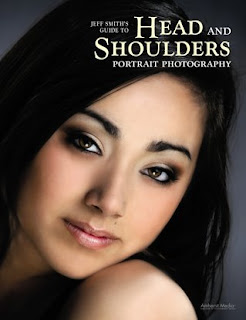 Today's post comes from the book Jeff Smith's Guide to Head and Shoulders Portrait Photography. It is available from Amazon.com and other fine retailers.
Today's post comes from the book Jeff Smith's Guide to Head and Shoulders Portrait Photography. It is available from Amazon.com and other fine retailers.In a head and shoulders pose, the composition of a portrait looks finished if the shoulders fill the bottom of the frame from one side to the other. If the portrait is composed showing more of the body, then the arms can be used to fill in the void areas at the bottom of the frame. Basically, this is completing a triangular composition, with the shoulders and arms forming the base of the triangle and the head at its peak. (Note: Many poses offer the photographer the ability to choose from different compositions. Poses like these work very well in high-volume photography studios. Once the subject is in the pose, you can make a full length or three-quarter-length image, then move in for a tighter head and shoulders image without having to re-pose the subject.)

The Shoulders. The widest view of any person is when the person is squared off to the camera. By turning the shoulders and torso to a side view, preferably toward the shadow side of the frame, you create the thinnest view of the body. The shoulders of a man should appear broad and be posed at less of an angle than the shoulders of a woman.

Additionally, portrait subjects appear stiff when their shoulders are running perfectly horizontal through the frame or when their spine (if you could see it) is running perfectly vertical in the frame. Posing the person reclining slightly backwards or leaning slightly forward, makes the shoulders and spine run diagonally through the frame for a more relaxed look. The portrait will have a professional look and it will be more visually appealing. It will also create a more flattering impression of the subject’s personality, making them look much less rigid.

Women’s shoulders can be a very appealing part of a portrait if posed properly. I like when my wife wears dresses that show off her shoulders. However, my wife is thin and very fit, unlike the majority of people we photograph each day. For this reason, it is always a good idea to have the shoulders covered with clothing if the subject’s weight is at all an issue.

Clothing itself, however, can create problems in this area of the body. Large shoulder pads in a jacket, for example, will make just about any kind of posing impossible; your client will look like a football player. As you can imagine, this is good for skinny guys but not so good for larger guys or any woman.
The Arms. Like the shoulders, arms often have problems that are best hidden by clothing, which is why we suggest that everyone wear long sleeves. Models may have perfect arms, but our clients are plagued with a variety of problems—arms that are too large or too boney, loose skin, hair appearing in embarrassing places, stretch marks, bruises, veins, etc. The list is a long one, so cover those things up.

To learn how to pose the arms, watch people as they are relaxing. They fold their arms, they lean back and relax on one elbow, they lay on their stomachs and relax on both elbows, or they will use their arms to rest their chin and head. However, any time weight is put onto the arms (by resting them on the back of a chair, the knee, etc.) it should be placed on the bone of the elbow. If weight is put on the forearm or biceps area, it will cause the area to mushroom and make it appear much larger in size than it actually is. This is another reason to have the arms covered if it at all possible.

*excerpted from the book Jeff Smith's Guide to Head and Shoulders Portrait Photography
BUY THIS BOOK FROM AMAZON










 The set of images here illustrates the effects of a 45-degree light setup that creates soft loop lighting. Starting with one main light, I progressively added light sources and reflectors to create classic portraits of Amanda.
The set of images here illustrates the effects of a 45-degree light setup that creates soft loop lighting. Starting with one main light, I progressively added light sources and reflectors to create classic portraits of Amanda.










